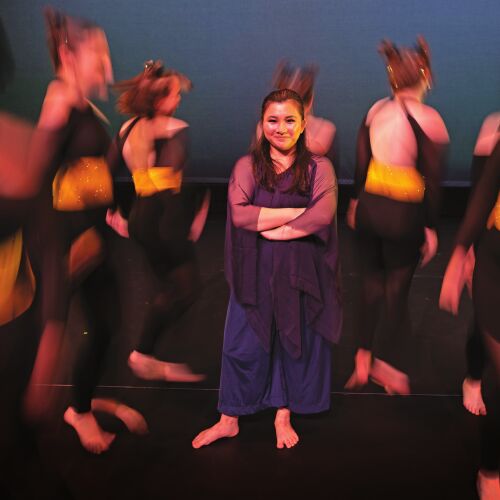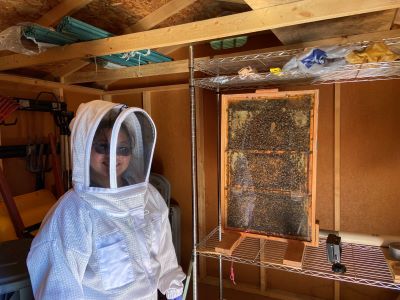
From pollination to performance: Biology and dance student brings the honeybee waggle to Wooster

As a member of The College of Wooster Dance Company and the cheerleading team, Katie Spence ’23 is no stranger to the stage. She began dance classes at the age of 3 and loved performing. “It was a perfect channel for my energy and a good creative outlet,” said Spence. She embraced that creativity all the way to her senior Independent Study at Wooster and combined the art of dance with the science of biology.
“The language and expectations for each of these fields could not be more different, yet Katie has found a way to connect them as I think only a Wooster student could,” said Emily Baird ’16, assistant professor of theatre and dance. Baird advised Spence for the dance piece and, as a Wooster alumna, also shed light on the I.S. experience. “I’ve really enjoyed our conversations about how to ‘think like a scientist’ or ‘think like an artist,’” she said.
“I.S. is not as scary as people make it out to be. By this point in your academic career, you are more than well equipped to handle I.S. Everything you’ve learned, academically and nonacademically, shapes and prepares you for the process.”
—Katie Spence ’23, I.S. Title: More Than a Hobby: Examining dance as communication in honeybees and humans, mentors Emily Baird, assistant professor of theatre and dance and Jennifer Ison, associate professor of biology
Spence knew the biology topic would dictate the dance element and requested to work with Jennifer Ison, associate professor of biology. Ison’s conservation work with bees and pollination, as well as her mentoring style and approach to peer-review, excited Spence. The collaboration couldn’t have been choreographed more perfectly to arrive at the honeybee waggle dance.
Honeybees perform the waggle dance inside their hive to communicate the distance, abundance, and direction of a nearby food source (such as nectar or pollen). Spence designed a uniquely collaborative I.S. project that looks at dance as communication in both humans and honeybees.
Spence moved back to campus early in August 2022 to begin her honeybee research. She set up an observation hive in Wooster’s pollinator garden on College Avenue and Pearl Street with bees, a camera, and lights all loaned from Ison’s colleague, Reed Johnson, from the Ohio Agricultural Research and Development Center (OARDC). Johnson helped Spence with the actual data collection and literature sourcing.

Spence wore protective equipment when she worked with the hive. Photo by Jennifer Ison
“The weather has to be sunny and with good temperatures for the bees to dance,” explained Spence, who recorded behavior on four separate days from noon to 5 p.m. “I used red lights to illuminate the hive and see the behavior because honeybees can’t see red. I’d leave the camera running for hours at a time to record their movement.”
Using image-analyzing software called Fiji, Spence converted video recordings into “photo stacks” and pinpointed where each dance started and stopped. She moved those data points into a spreadsheet and then a coding program to create dance maps. This analysis process took five or more hours to transcribe one hour of video footage.
Spence applied Laban Movement Analysis (named for choreographer Rudolf Laban, the first person to quantify human movement) to honeybees. “Because humans and honeybees have very different anatomies, I thought their actual movement would be very different,” said Spence. “After looking at Laban’s efforts, I was surprised that there is a lot of crossover.”
In addition to the roughly 100-page written thesis that explains her research, data collection, and analysis, Spence also choreographed a dance piece using the honeybees as inspiration. It featured seven dancers with music composed by a music major, and it was performed at Wooster’s Spring Dance Concert. “Katie analyzed the movement of honeybees and essentially interpreted it into human movement to create her own dance language. It was fascinating,” said Baird.
Spence is adamant that Wooster prepared her in so many ways to tackle the magnitude of a collaborative I.S. From the introductory biology classes and labs that prepared her to write a scientific paper on the college level, to advanced biology where she learned research skills like analyzing data and how to properly conduct an experiment.
She also raved about the opportunity to travel to London in July 2022 to study performance with the Department of Theatre and Dance. “I saw 21 shows in 26 days and presented a final project about what I learned about drawing the audience’s attention through performance,” said Spence. She insists that the report “didn’t feel like work over there,” but it helped ignite the start of her I.S. when she returned. “It’s not as scary as people make it out to be,” Spence affirmed. “By this point in your academic career, you are more than well equipped to handle I.S. Everything you’ve learned, academically and nonacademically, shapes and prepares you for the process.”
She’s prepared to waggle after Wooster too. Spence has applied to several graduate schools for biology, and says she’d love to continue studying honeybees.
Posted in Independent Study on July 13, 2023.
Related Posts
Related Areas of Study
Theatre & Dance
Scholarship and artistry in theatre and dance for those who are passionate about performance in all its forms.
Major MinorBiology
Explore molecular and cellular biology, ecology and more with top faculty and access to extensive lab facilities.
Major Minor

